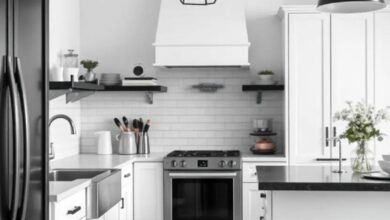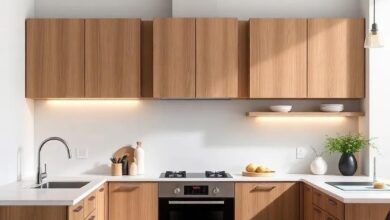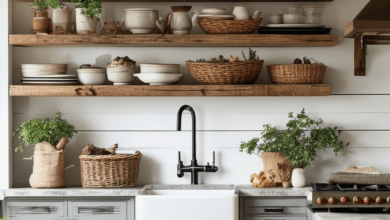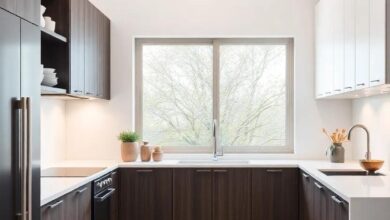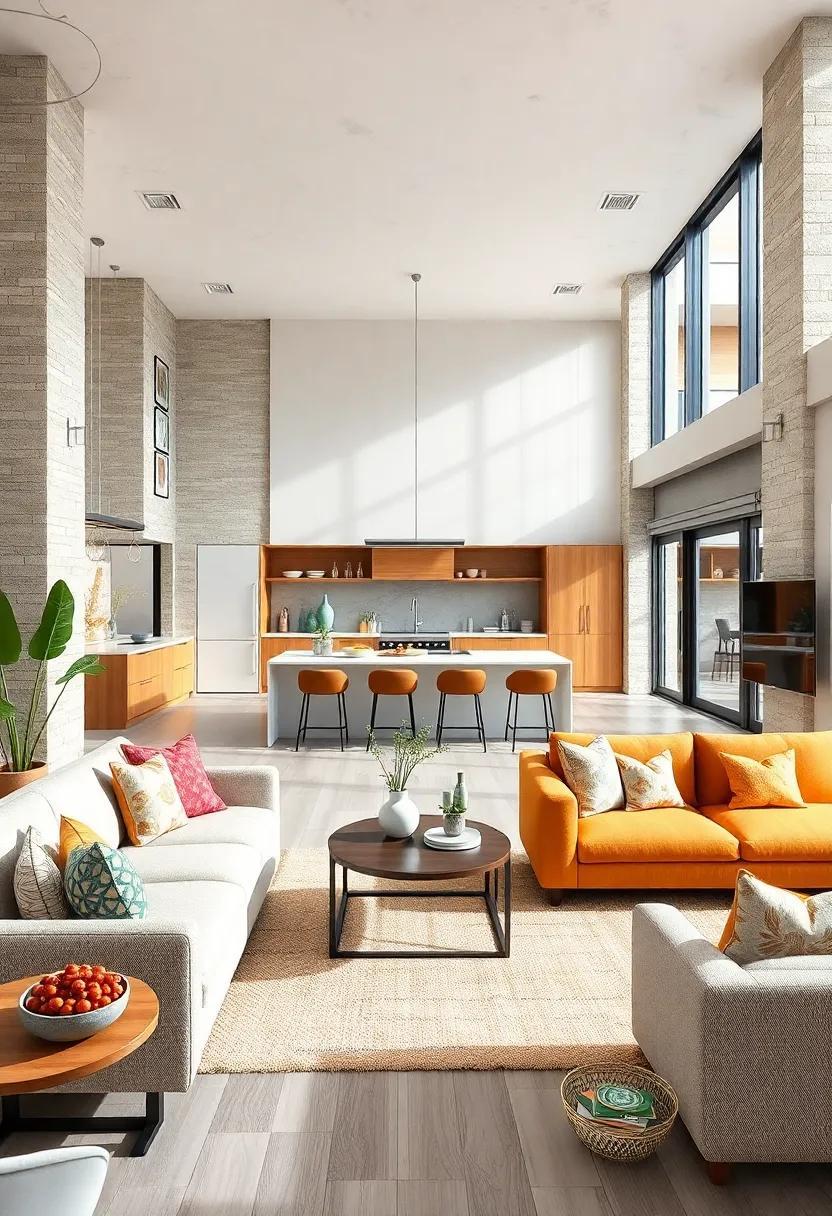
25 Inspiring Ideas for Designing the Perfect Open Concept Kitchen and Living Room
Blending the heart of the home-the kitchen-with the comfort of the living room has become a favorite way to create inviting, functional spaces that foster connection and flow. If your dreaming of an open concept design that perfectly balances style and practicality,you’ve come to the right place. in this listicle, you’ll discover 25 inspiring ideas that reveal how to transform your kitchen and living area into a seamless, harmonious surroundings. From clever layout tips and lighting tricks to smart storage solutions and design accents, these ideas will help you craft a space that feels spacious, welcoming, and perfectly tailored to your lifestyle. Whether you’re starting from scratch or looking to refresh your current setup, get ready to unlock the full potential of your open concept home.
Embrace natural light with expansive windows and skylights to create a bright and inviting open space
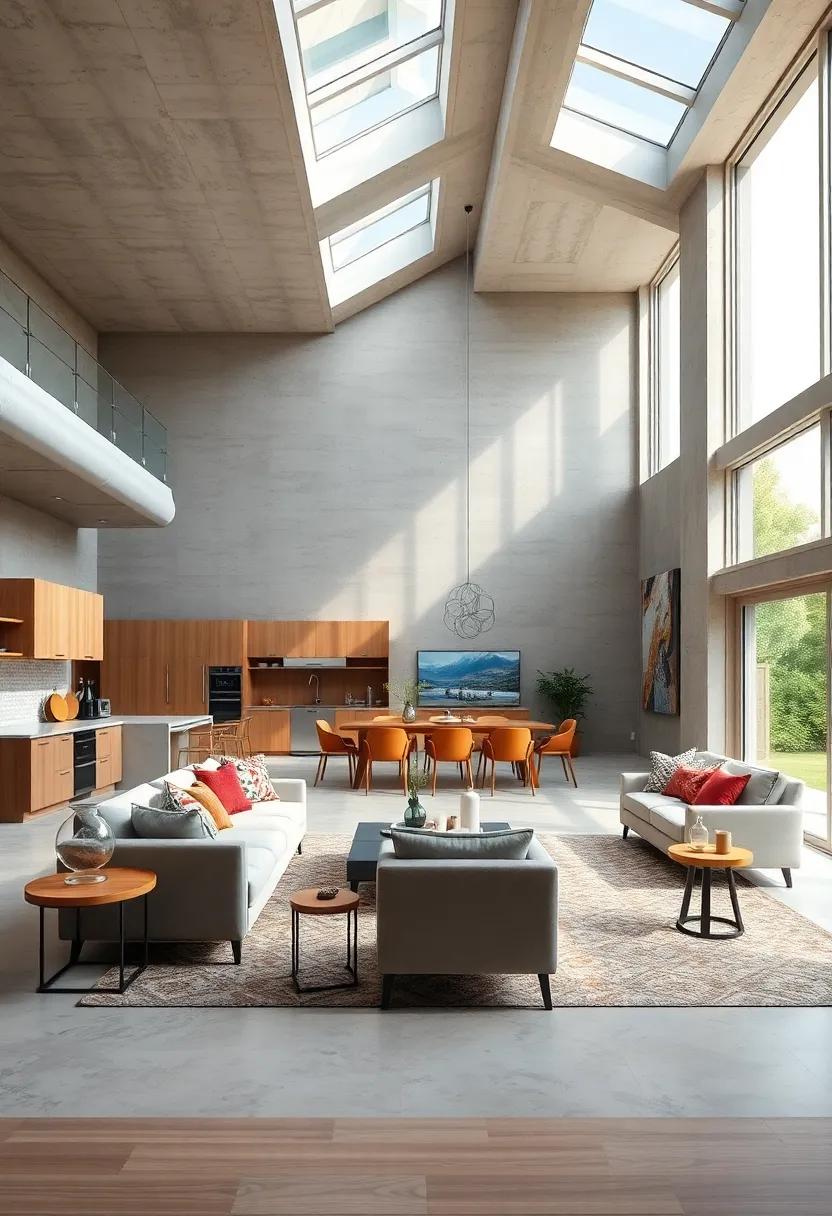
Integrating large windows and strategically placed skylights can transform your kitchen and living room into a luminous haven that feels both spacious and welcoming. Expansive glass panels invite the outdoors in, filling the space with natural sunlight that energizes the environment and highlights your design elements. Beyond aesthetics, natural light improves well-being and creates a dynamic ambiance that changes throughout the day, offering a rhythm and flow that artificial lighting can’t replicate.
To maximize the effect, consider the following design touches:
- Floor-to-ceiling windows: Frame stunning outdoor views and make your open concept area appear larger.
- Operable skylights: Enhance ventilation and provide fresh air, perfect for cooking aromas and comfort.
- Light-diffusing window treatments: Maintain privacy without sacrificing brightness.
| Window Type | benefit | Ideal Placement |
|---|---|---|
| Picture Windows | Unobstructed views and maximum light | Living room walls facing natural scenery |
| Skylights | Daylight boost and passive solar heating | Above kitchen island or dining area |
| Bay Windows | Cozy seating nook with extra daylight | Lunch area adjacent to the kitchen |
Use a cohesive color palette to unify the kitchen and living room for a seamless flow
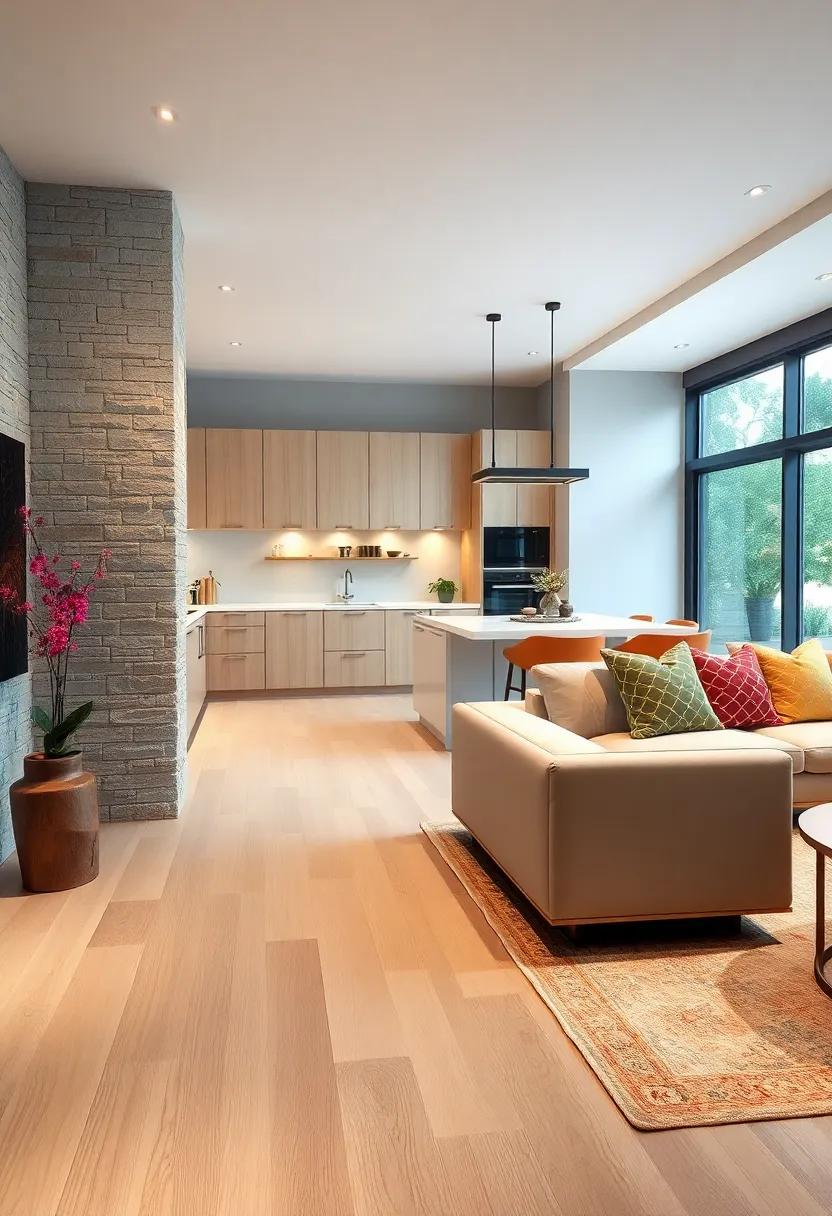
Bridging the gap between your kitchen and living room is all about selecting a color story that speaks the same language across spaces. Choose a palette with complementary shades that balance warmth and neutrality, allowing each area to shine without competing. such as, soft grays paired with muted blues or warm beige tones accented by subtle greens can create a tranquil yet cohesive environment. Incorporating these colors through paint,textiles,and accessories helps your eye travel effortlessly from countertop to couch,giving the entire space a harmonious feel.
Consistency in color doesn’t mean monotony – use varying textures and finishes within your chosen palette to add depth and character. Think matte cabinets alongside glossy tiles, or a plush rug offset by sleek leather seating in matching hues. This layering technique enriches the visual experience, making the open concept feel thoughtfully designed rather than thrown together. Below is a simple guide to exploring your palette options and their ideal room pairings:
| Palette | Kitchen Accent | Living Room Detail | Overall Mood |
|---|---|---|---|
| Soft Gray + Blue | Subway tile backsplash | Velvet throw pillows | Calm & inviting |
| Warm Beige + Sage Green | Wooden cabinetry | Linen curtains | Natural & Cozy |
| Charcoal + Mustard | Matte countertops | Patterned rugs | Modern & Energetic |
- TIP: Carry smaller collectibles or art pieces in your palette tones to subtly tie both rooms together.
- TIP: Use consistent finishes, like brushed metals or matte ceramics, alongside your colors for a polished effect.
Incorporate multitasking furniture like kitchen islands that double as dining tables or workspaces
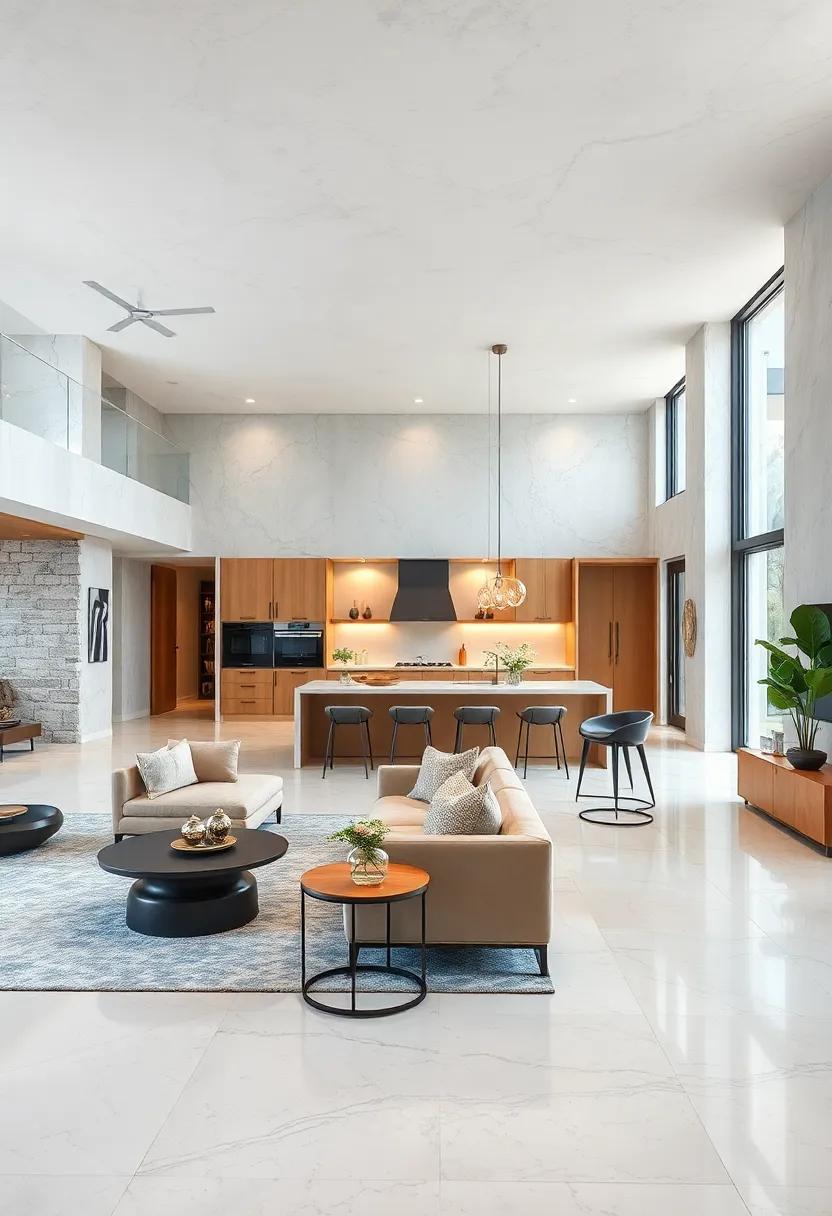
Maximize your floor space with clever, multitasking furniture that seamlessly adapts to your lifestyle. Opt for kitchen islands designed not just for meal prep, but also as hubs for casual dining and productive work. These versatile pieces serve as a natural gathering spot, bridging the gap between kitchen and living areas while offering ample countertop space for cooking, eating, and even laptop time. By integrating storage drawers or shelves beneath, you can keep essentials within arm’s reach without cluttering your counters, maintaining a sleek and open atmosphere.
Choose finishes and materials that complement both your kitchen and living room décor to enhance flow and visual cohesion. For example, a wooden island with a polished stone top can harmonize rustic charm with modern elegance. Consider the following benefits of multitasking kitchen islands:
- Space-saving – replaces multiple pieces of furniture with one multi-functional unit
- Social connectivity – encourages interaction between cooks and guests
- Enhanced organization – built-in storage keeps clutter hidden
- Customizable zones – designated areas for work, dining, and food prep
| Function | Feature | Benefit |
|---|---|---|
| Workstation | Pull-out keyboard tray | Ergonomic office setup |
| Dining | Extendable countertop | Accommodates more guests |
| Storage | Hidden cabinets | Clutter-free environment |
Define zones with area rugs that add texture and warmth while delineating living and cooking areas
area rugs are a brilliant and versatile tool for defining distinct zones within an open concept kitchen and living room. By carefully selecting rugs with different textures,patterns,and colors,you not only anchor each space visually but also introduce layers of tactile warmth underfoot. imagine a plush, patterned rug grounding your cozy living area while a flatweave or natural fiber rug under the dining table adds a rustic touch that’s easy to clean. This contrast in textures creates a natural division without the need for walls or bulky furniture, maintaining an airy and connected atmosphere.
To maximize the effect, consider the size and placement of each rug.A larger rug works well under the main seating group, inviting everyone to gather comfortably, while smaller rugs can highlight kitchen islands or eating nooks. Don’t shy away from bold colors or geometric designs-they can act as visual cues that signal different functions within the space. Here’s a rapid guide on choosing the right rugs for each zone:
| Zone | Ideal Rug Type | Texture | Benefit |
|---|---|---|---|
| Living Area | Plush, high-pile | Soft, cozy | Comfort, warmth |
| Dining/Kitchen Area | Flatweave, natural fibers | Durable, easy to clean | Practicality, style |
| Transition Spaces | Runner rugs | low pile, patterned | Visual flow, legibility |
Opt for flexible seating arrangements such as modular sofas to adapt to different gatherings
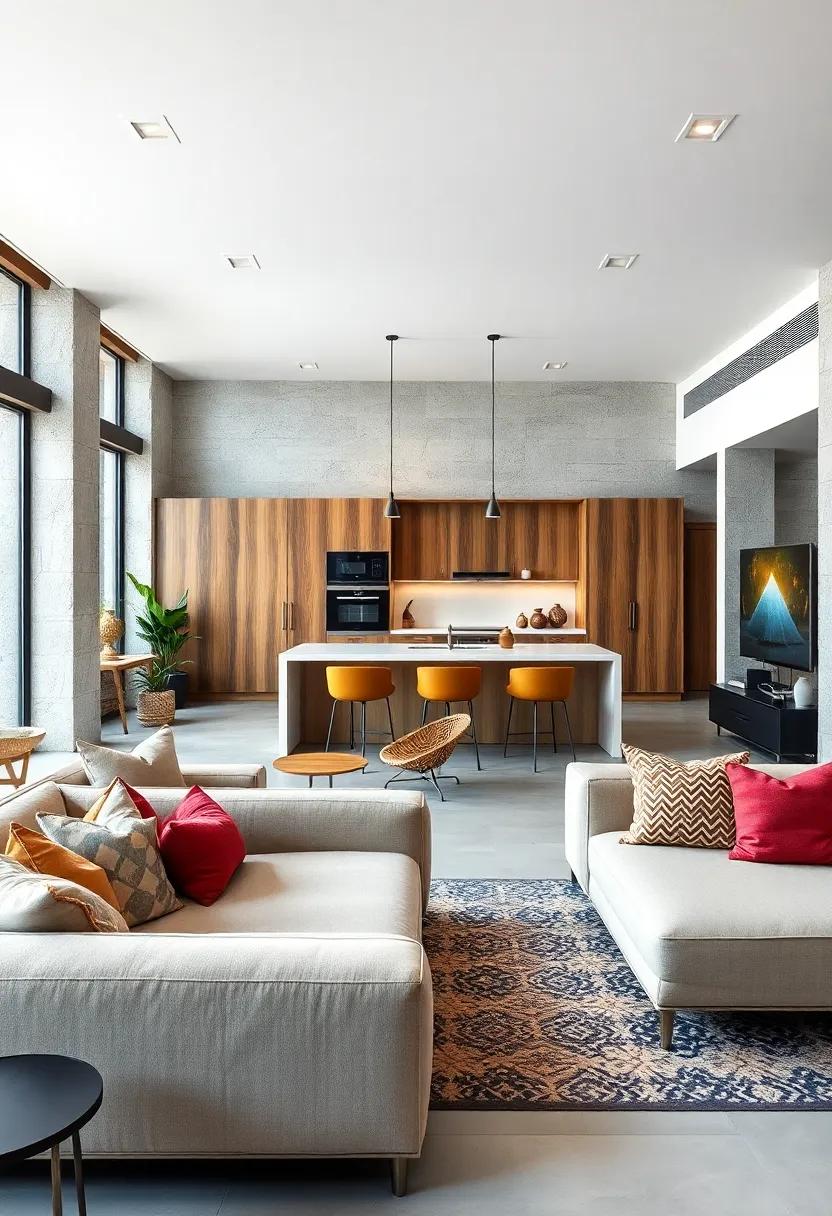
Creating a versatile seating area is essential to maximizing the potential of your open concept kitchen and living space. Modular sofas offer a dynamic solution, allowing you to effortlessly reconfigure the layout to suit everything from intimate family movie nights to lively dinner parties. Their individual sections can be moved around or detached, giving you the freedom to expand or condense your seating without compromising on style or comfort.
Consider incorporating pieces with built-in storage or multi-functional features to make your space even more adaptable. Here’s why modular seating works so well:
- Customizable comfort: Arrange sections to fit your unique space and preferred social setup.
- Easy to expand: Add or remove modules based on the number of guests.
- Maintains flow: Flexible shapes help create clear pathways between kitchen and living areas.
- Stylish cohesion: Select fabrics and colors that unify your open concept design.
Install statement lighting fixtures that serve both functional and decorative purposes across the open area
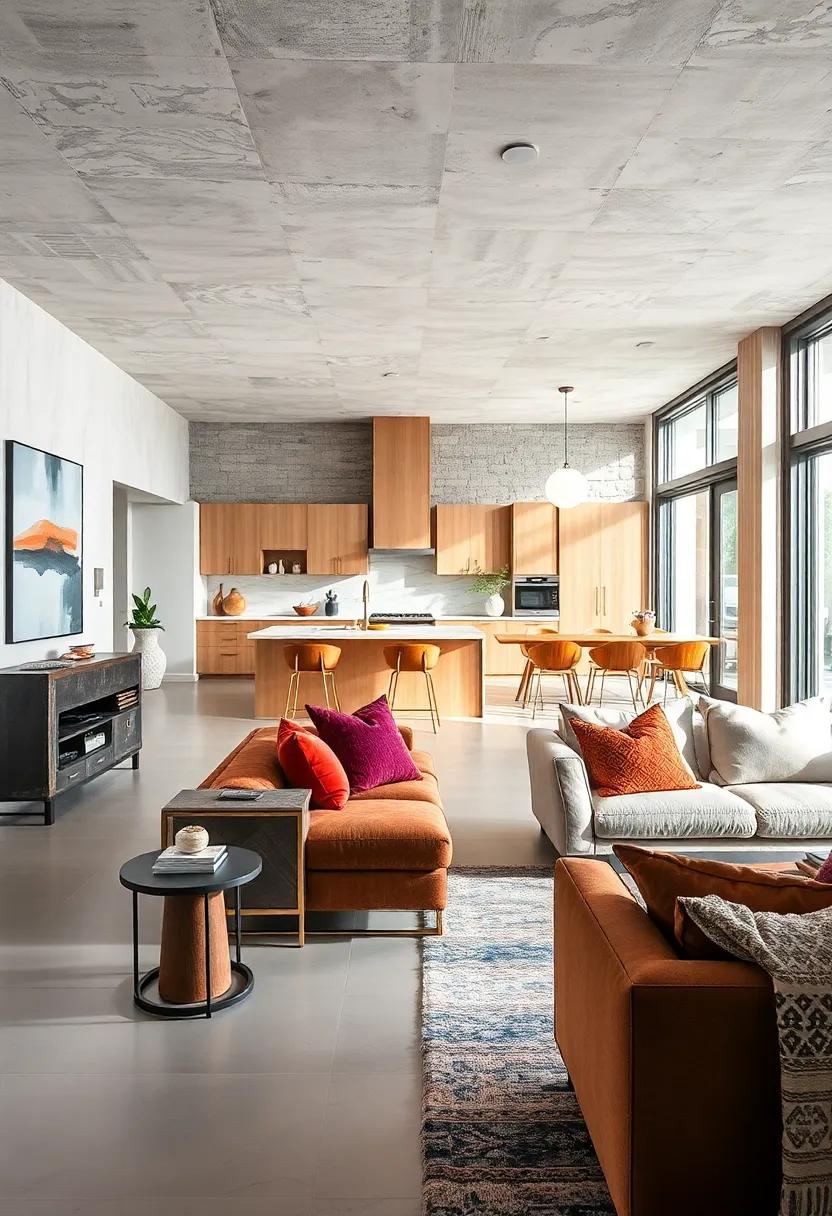
Lighting plays a pivotal role in harmonizing the kitchen and living room within an open concept layout. Opt for fixtures that not only illuminate tasks but also act as artistic focal points. Consider pendant lights with sculptural designs suspended over kitchen islands,paired with recessed lighting or wall sconces that softly highlight cozy seating areas. This layering technique balances practicality with aesthetics, creating an inviting ambience that adapts seamlessly from bright meal prepping to relaxed evening gatherings.
Key lighting choices to explore include:
- Adjustable track lighting that directs light where needed most
- Chandeliers with mixed materials like metal and glass for texture
- LED strip lights beneath cabinetry doubling as mood and task lighting
- Statement floor lamps that provide warmth and vertical interest
| Fixture Type | Function | Decorative Appeal |
|---|---|---|
| Pendant Lights | Focused task illumination | Eye-catching sculptural design |
| Recessed Lights | Even ambient lighting | Minimalist aesthetic |
| Wall Sconces | Accent and mood lighting | Architectural detailing |
Choose durable, easy-to-clean flooring that complements both kitchen and living room aesthetics
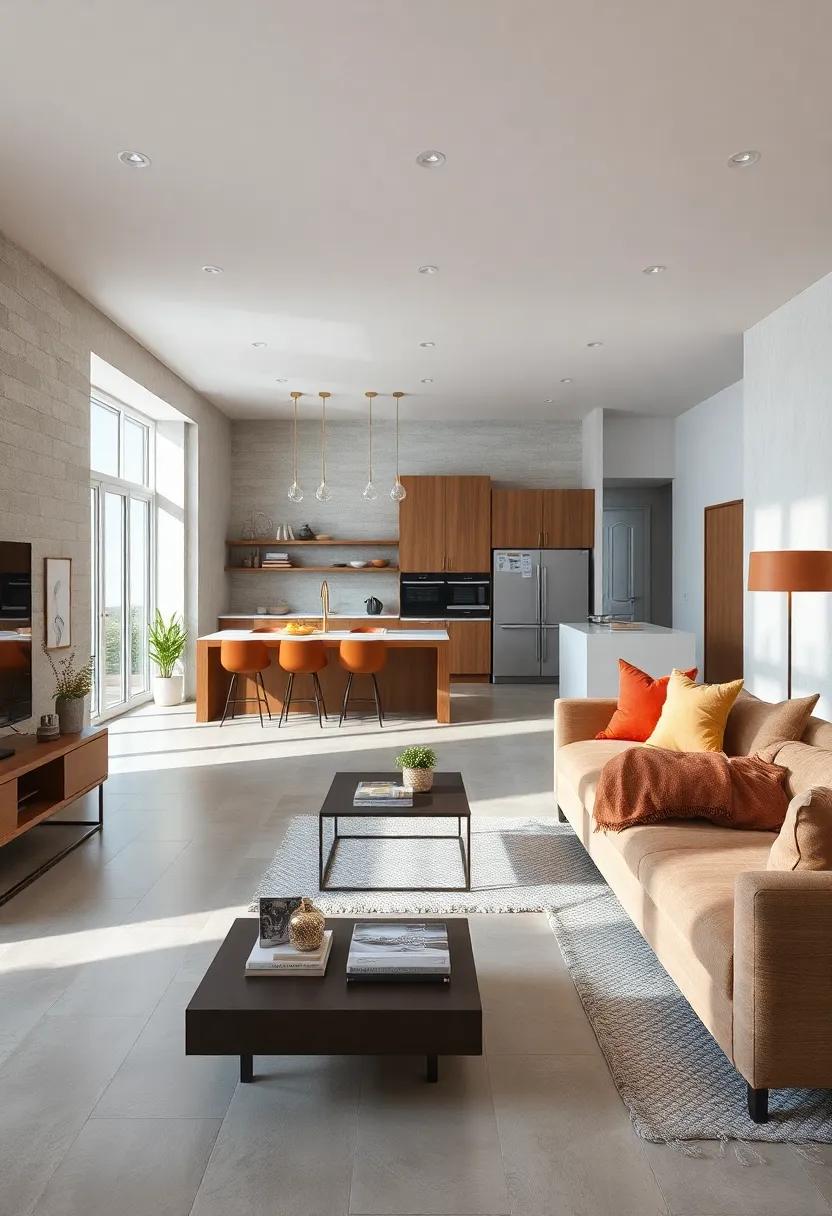
When selecting flooring for an open concept kitchen and living room, opting for materials that withstand high traffic and resist spills is essential. Engineered hardwood, luxury vinyl planks (LVP), and porcelain tiles offer a seamless blend of durability and style, making cleanup a breeze while elevating your space’s aesthetic. These surfaces not only endure the everyday hustle of cooking and lounging but also add warmth and texture, tying together the distinct functions of the room without visual interruption.
Consider how color and finish impact both maintenance and atmosphere. light-colored floors with matte finishes can mask dust and scratches better than glossy surfaces, while medium-toned woods or stone-inspired tiles introduce a balanced backdrop. Below is a quick reference guide to help you compare popular flooring options:
| Flooring Type | Durability | Ease of Cleaning | Aesthetic Appeal |
|---|---|---|---|
| Engineered Hardwood | High | Moderate | Warm, Classic |
| Luxury Vinyl Planks (LVP) | Very High | Very Easy | Versatile, Modern |
| Porcelain Tile | Very High | Easy | Elegant, Sleek |
| Laminate | Moderate | Easy | Budget-Friendly, Stylish |
- Pro tip: choose flooring with water-resistant properties near the kitchen area to avoid damage from spills.
- Design harmony: Match flooring tones and textures with furniture and cabinetry for a cohesive look.
Integrate built-in storage solutions to maintain a clutter-free and organized environment
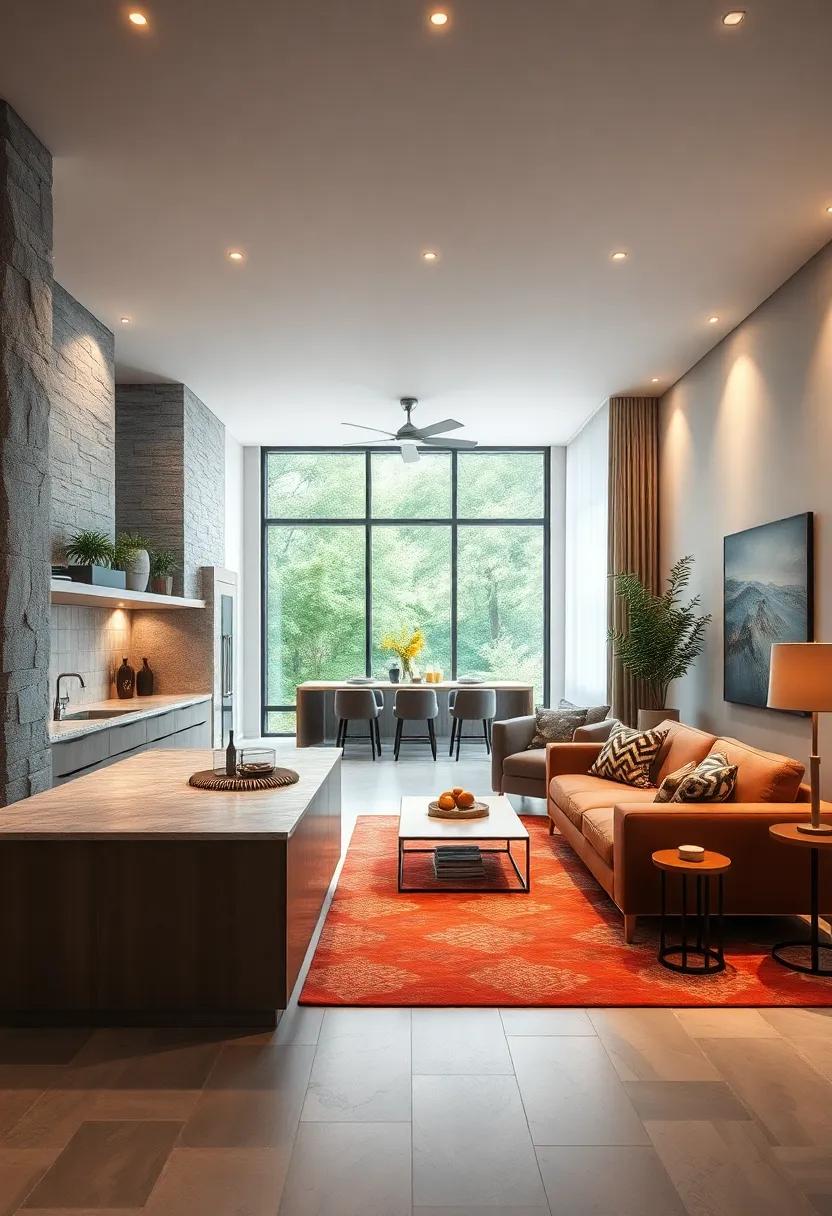
Seamlessly incorporating built-in storage transforms your open concept kitchen and living area into a haven of style and functionality. Think beyond customary cabinetry-embed sleek drawers beneath kitchen islands, create hidden compartments in seating benches, or utilize vertical niches along walls for displaying chic dishware or books. These thoughtful storage solutions not only keep clutter at bay but also blend effortlessly with your décor, preserving the fluidity of the open space. Opt for consistent finishes and handle-free designs to maintain a minimalist, uninterrupted flow that enhances the room’s airy essence.
To maximize efficiency, consider modular units that adapt to your needs, such as pull-out spice racks, integrated charging stations, or multi-tiered pantry organizers. below is a simple reference chart featuring popular built-in storage options and their best uses in an open floor plan:
| Storage Solution | Ideal Location | Key Benefit |
|---|---|---|
| Under-island Drawers | Kitchen Island | accessible cookware storage |
| Built-in Bench Seating | Living/Dining Area | Dual seating and hidden storage |
| Vertical Wall Cabinets | Kitchen & Living Room Walls | Display and organization |
| Concealed Media Units | Living Room | Electronics tucked away |
Design a feature wall with bold tiles or textured materials to create visual interest without interrupting openness
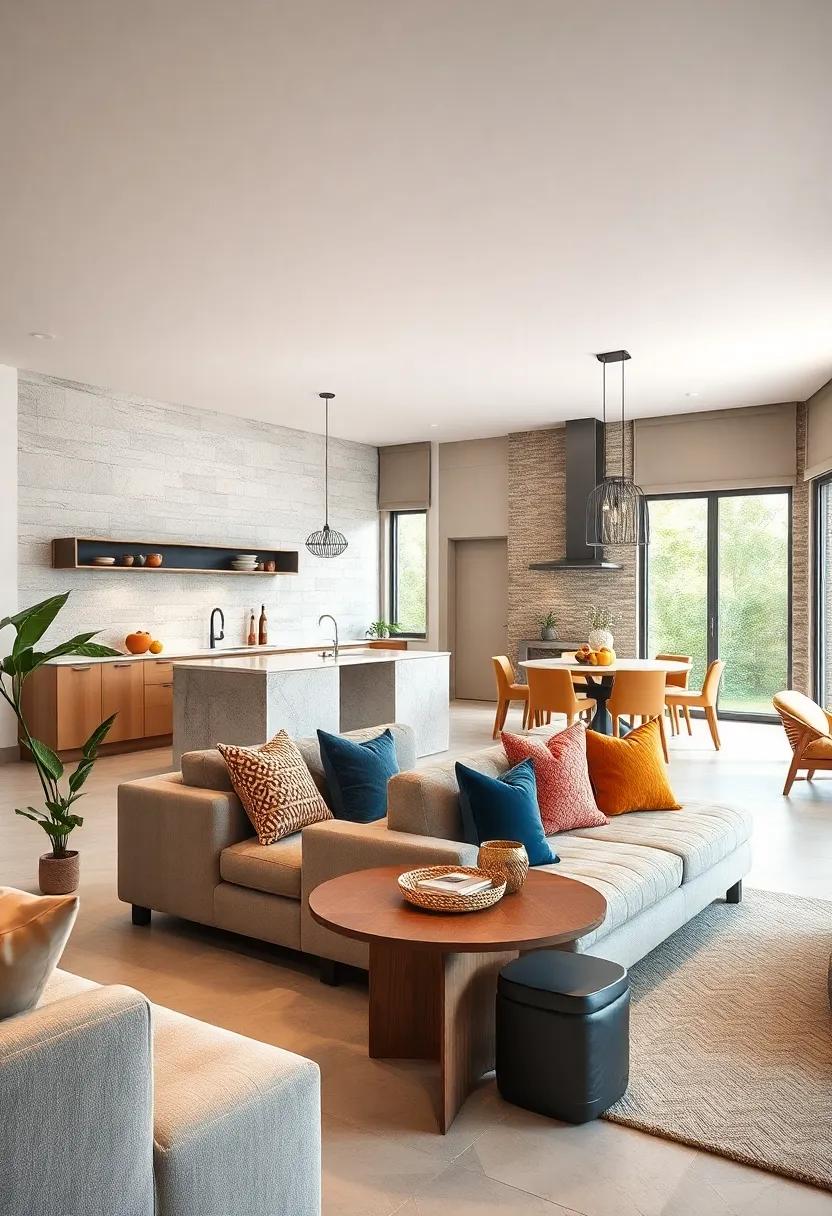
Inject personality into your open concept kitchen and living area by incorporating a striking feature wall that commands attention yet respects the flow of the space. Opt for bold tiles in geometric patterns or vivid colors that contrast subtly with neutral tones surrounding them. Alternatively, textured materials like reclaimed wood panels, natural stone, or 3D wall cladding can add depth and tactile intrigue without overwhelming the openness. These elements act as artistic focal points that draw the eye, balancing aesthetic appeal and spatial harmony.
To maintain an airy atmosphere, pair your feature wall with minimalist furnishings and avoid clutter around it. Consider the following design options for a standout, yet cohesive statement:
- Ceramic or porcelain tiles: Matte or glossy finishes with bold patterns or metallic accents.
- Textured plaster or Venetian stucco: Adds subtle movement and luxury.
- natural materials: Split-face stone or vertical wood slats for organic warmth.
- Wallpaper with dimensional effects: Raised patterns or grasscloth for soft texture.
Blend natural elements like wood accents and indoor plants to add warmth and freshness
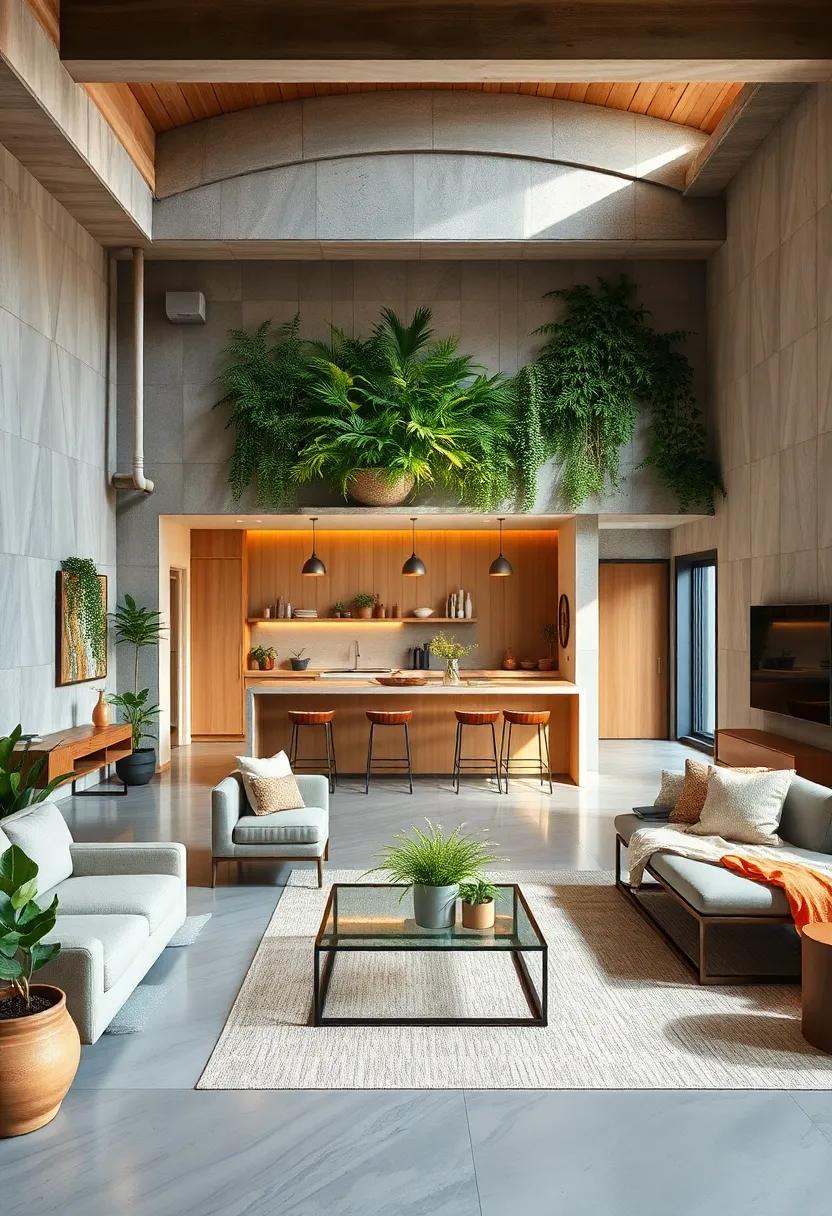
Incorporating wood accents into your open concept space instantly infuses warmth and a touch of nature. Think exposed wooden beams, rustic shelves, or even a reclaimed wood kitchen island countertop. These elements create a cozy visual anchor, balancing the clean, airy feel typical of open layouts. Pairing smooth, polished finishes with textured wood surfaces introduces contrast and depth, making the space feel intentionally curated yet effortlessly welcoming.
Meanwhile, indoor plants serve as living decor that breathes freshness into every corner. From trailing pothos cascading down bookshelves to sculptural fiddle leaf figs standing tall near seating areas,greenery enlivens the environment while promoting well-being. Mixing a variety of plant types and sizes enhances the organic vibe, while stylish planters in natural materials like ceramic, rattan, or terracotta tie the look together. Layering these natural touches maintains an inviting atmosphere that thrives on simplicity and authenticity.
Incorporate smart home technology for lighting, sound, and appliances to enhance convenience and ambiance
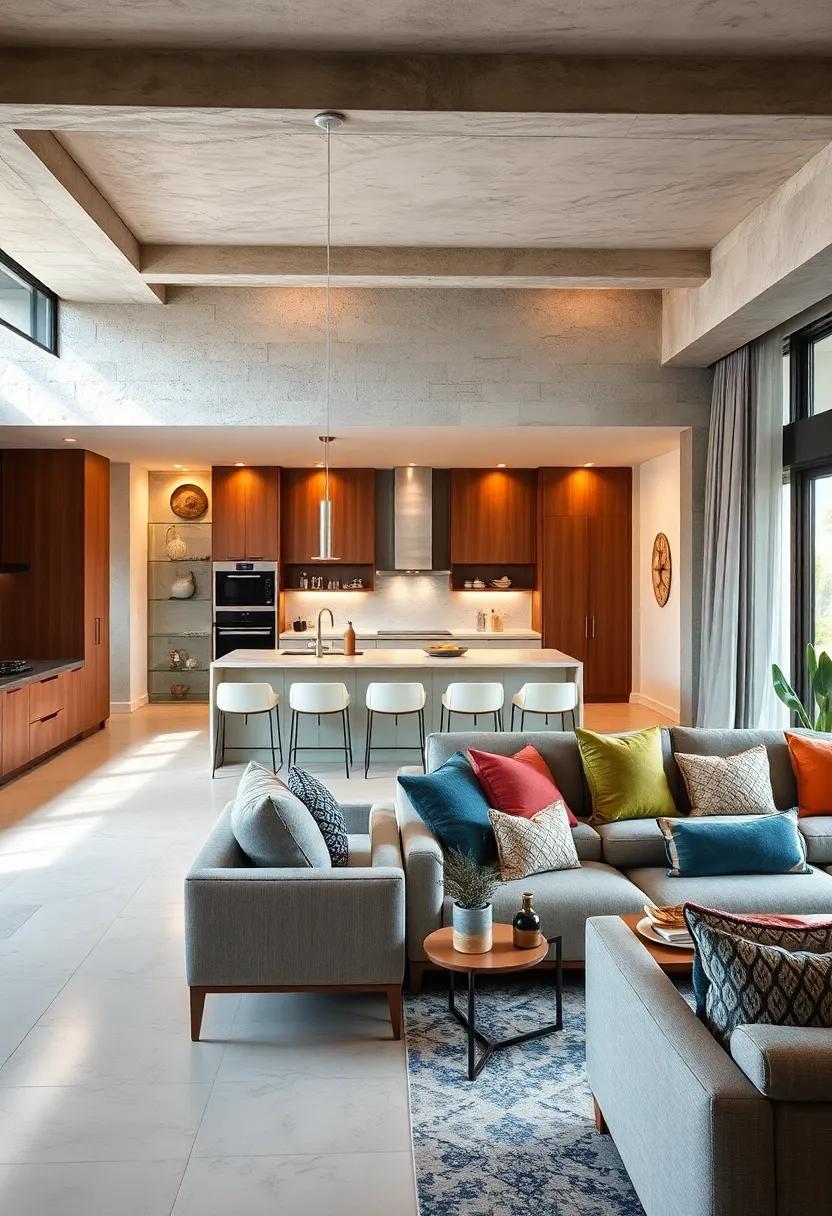
Transform your open concept kitchen and living room into a seamless,futuristic haven by integrating smart home technology that caters to lighting,sound,and appliances. Imagine setting the perfect mood with a simple voice command-dimmable LED lights that adjust their warmth and intensity based on the time of day, or strategically placed smart speakers delivering immersive soundscapes as you cook or entertain. These intelligent systems not only elevate the ambiance but also streamline your daily routines, allowing you to focus on what truly matters: enjoying your space.
To better visualize the benefits, here’s a quick overview of popular smart home features tailored for an open concept setting:
| Feature | Function | Benefit |
|---|---|---|
| smart Lighting | Adjust color & brightness | Sets customized moods effortlessly |
| Integrated Sound Systems | Multi-room music control | Immersive audio experience throughout |
| Smart Appliances | Remote operation & status updates | Ensures efficiency and convenience |
By blending these technologies, you create a living environment that’s not only stunning but intuitive-where your surroundings respond to your needs and elevate everyday living with effortless style and control.
Use open shelving to display beautiful kitchenware and personal decor, adding character to the space
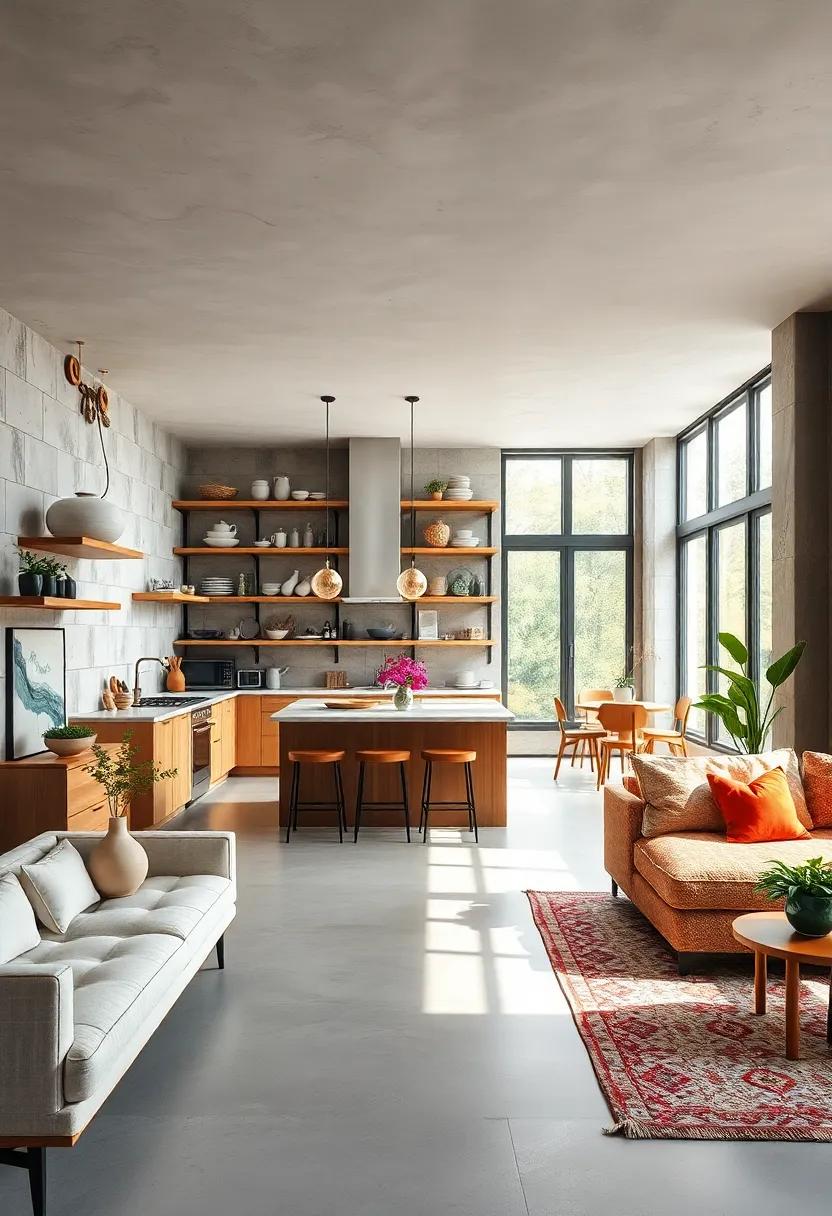
Open shelving offers a brilliant way to blend functionality with personal style, turning your kitchen into a vibrant canvas.Showcasing your favorite kitchenware-from vintage ceramic bowls to sleek glass jars-breathes life into the room and transforms everyday essentials into eye-catching decor. Mixing textures and colors not only brings warmth but also invites a tactile experience that closed cabinets simply can’t offer. don’t hesitate to intersperse your cookware with handcrafted vases, unique cookbooks, or cherished collectibles to create layers of visual interest that tell your story.
To maintain balance and avoid clutter, consider grouping items by theme or color palette. Using natural materials like wood or rattan baskets on the shelves can add texture and help organize smaller items neatly. Here’s a quick guide to styling your shelves with flair:
| Styling Tip | Example | Result |
|---|---|---|
| mix heights and shapes | Tall glass carafe + low stoneware bowls | Creates dynamic visual flow |
| Include personal mementos | Framed family photo or heirloom teapot | Adds character and sentiment |
| Use open baskets | Wicker baskets for loose items | Keeps space tidy while adding texture |
| Limit color palette | Earth tones with pops of blue | Enhances cohesion and calm |
Create an unobstructed sightline between kitchen and living areas for better interaction and flow
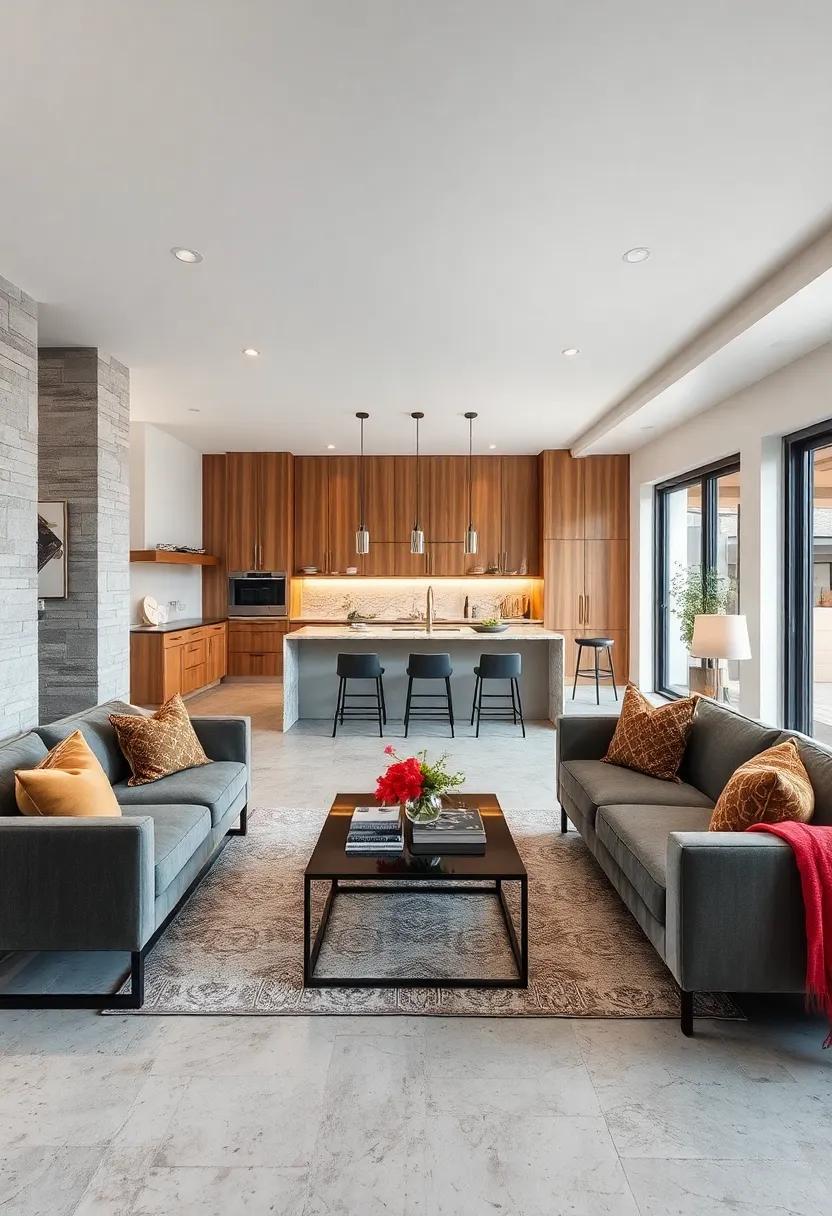
An open line of sight between your kitchen and living room transforms everyday routines into shared experiences. By removing unneeded walls or bulky furniture that obstruct views, you encourage seamless interaction and create a more inviting atmosphere. Imagine cooking up a storm while still engaging in conversation, keeping an eye on the kids, or watching your favorite show without missing a beat. This unobstructed flow not only maximizes natural light but also visually expands your space, making it feel airy and connected.
To maintain this clarity, opt for streamlined design elements such as low-profile island seating, open shelving, and transparent room dividers like glass panels. Consider the placement of lighting fixtures and furniture to avoid blocking pathways or sightlines. Here’s a quick comparison to illustrate the impact:
| design Element | Obstructed Sightline | Unobstructed Sightline |
|---|---|---|
| Kitchen Island height | High counters block view | Lower counters allow eye contact |
| furniture Placement | Sofas face away from kitchen | Seating arranged to face kitchen |
| Room Dividers | Solid walls or bulky cabinets | Glass panels or open shelving |
Select complementary furniture styles that harmonize rather than compete across the two areas
When furnishing an open concept kitchen and living room, choosing pieces that complement each other’s style is key to creating a cohesive space that flows naturally.Rather of matching everything perfectly, aim for harmony through shared elements like color palettes, materials, or finishes. As an example, if your kitchen showcases sleek stainless steel appliances, consider mixing in living room furniture with brushed metal accents or minimalist legs to subtly echo that modern vibe without overwhelming the senses.
Texture and scale also play a crucial role in balancing the two areas. Soft upholstery paired with polished wood surfaces can create a pleasing contrast that invites comfort while maintaining sophistication.Try incorporating pieces with similar design motifs-such as clean lines or rounded edges-but varied enough in form to keep each zone uniquely inviting.Here’s a quick table to inspire your selection process:
| Kitchen elements | Complementary Living Room Pieces |
|---|---|
| Matte Black fixtures | Charcoal Fabric Sofa with Metal Legs |
| Natural Wood Cabinetry | Wood-Framed armchair with linen Cushions |
| Modern Pendant Lighting | Minimalist coffee Table in Glass & Metal |
| Marble Countertops | Stone-Colored Area Rug |
Incorporate a versatile breakfast bar that can serve as casual dining or a gathering spot
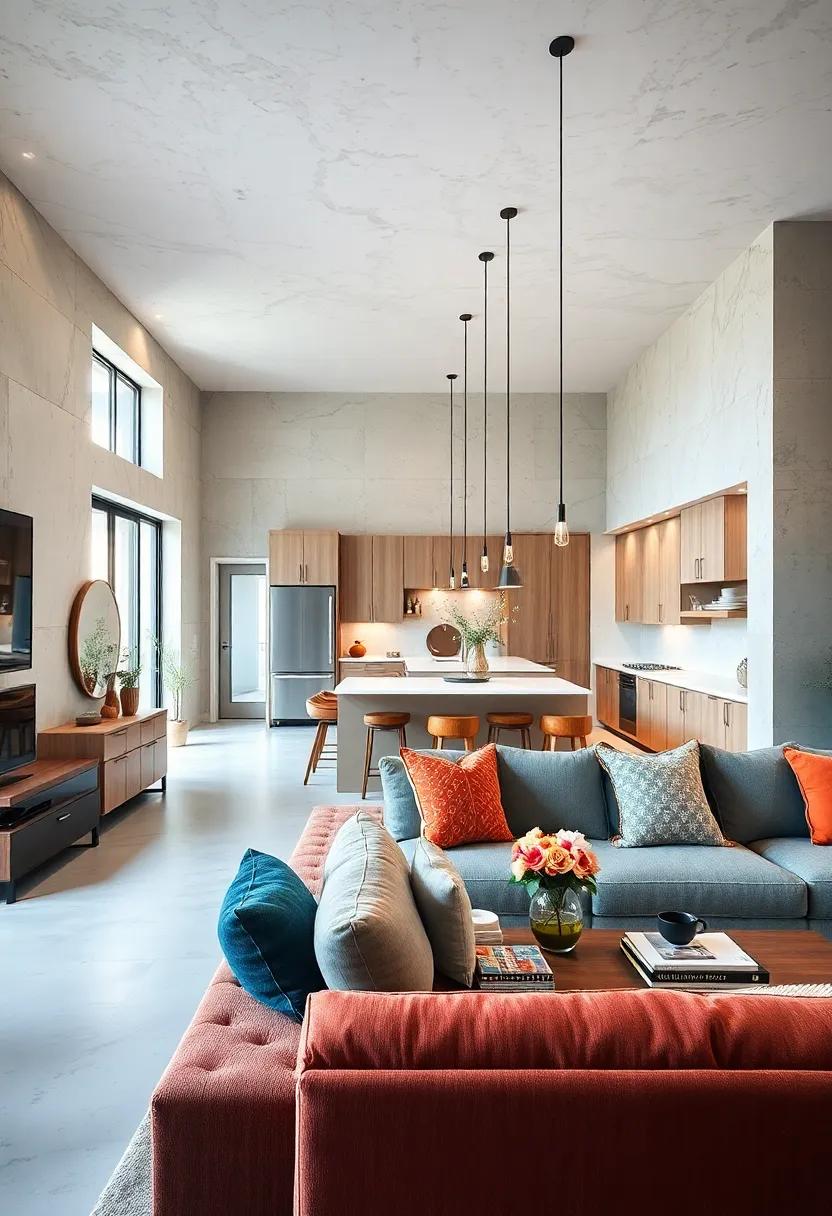
Elevate your open concept space by integrating a breakfast bar that effortlessly adapts to your lifestyle. This multifunctional feature provides a seamless transition between kitchen and living areas, encouraging casual dining and spontaneous gatherings. Opt for durable materials like quartz or butcher block for the countertop to ensure longevity, while incorporating cozy stools that invite guests to linger. By positioning the bar strategically, you create a natural flow that enhances social interaction without sacrificing utility.
To maximize versatility, consider adding clever storage solutions beneath the breakfast bar. This keeps clutter out of sight while maintaining easy access to essentials such as cookbooks, serving trays, or extra dishware. Additionally, subtle lighting-such as pendant lamps or LED strips-can transform the bar area from a daytime dining nook to a cozy evening hotspot. Below is a simple guide to selecting seating options based on your space and style:
| Seating Style | Best For | Visual Effect |
|---|---|---|
| Backless Stools | Small Spaces | Minimalist & Open |
| Upholstered Chairs | Comfort & style | Warm & Inviting |
| Swivel Stools | Entertaining | Dynamic & Fun |
Utilize sliding or pocket doors to offer flexibility between open and closed spaces when needed
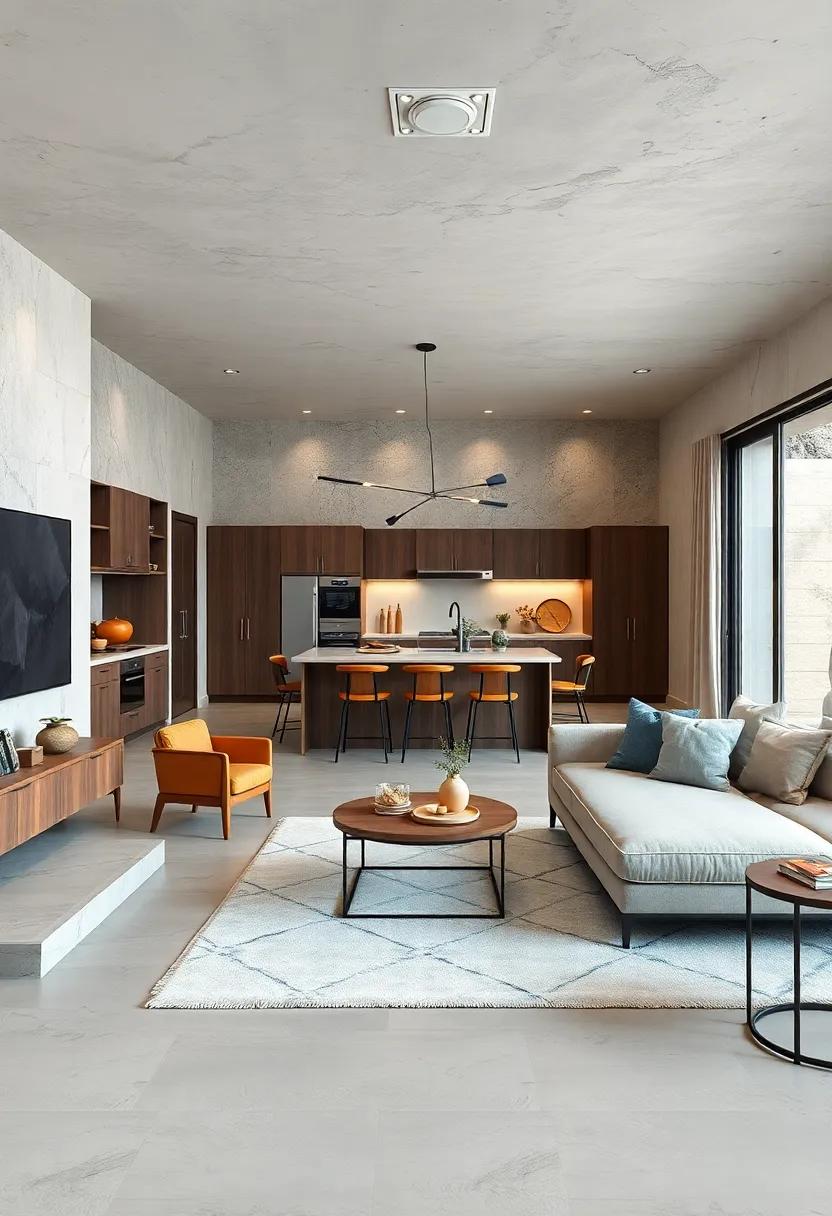
Sliding and pocket doors are game-changers when it comes to blending functionality with style in open concept living spaces. Their sleek design doesn’t intrude on your floor plan, allowing you to maintain an airy, spacious feel when open, yet instantly create privacy or contain cooking aromas when closed. Whether you want to host a lively gathering or enjoy a quiet evening, these doors offer seamless control over your environment without disrupting the flow of natural light or the aesthetic continuity between your kitchen and living room.
Besides their space-saving attributes, these doors come in a variety of finishes and materials, making it easy to customize for both modern and traditional interiors. Consider options like frosted glass for a hint of privacy that still lets light filter through, or rich wood panels to add warmth and texture. The flexibility they provide is unmatched:
- Maximize space: No door swing zones means more usable square footage.
- Design harmony: Blend seamlessly with cabinetry, walls, or accent features.
- noise control: Close off buzzing kitchen appliances when desired.
- Visual connectivity: Keep spaces open or subtly separated without major renovations.
Add a pop of color with accent walls or decor pieces to energize and personalize the space
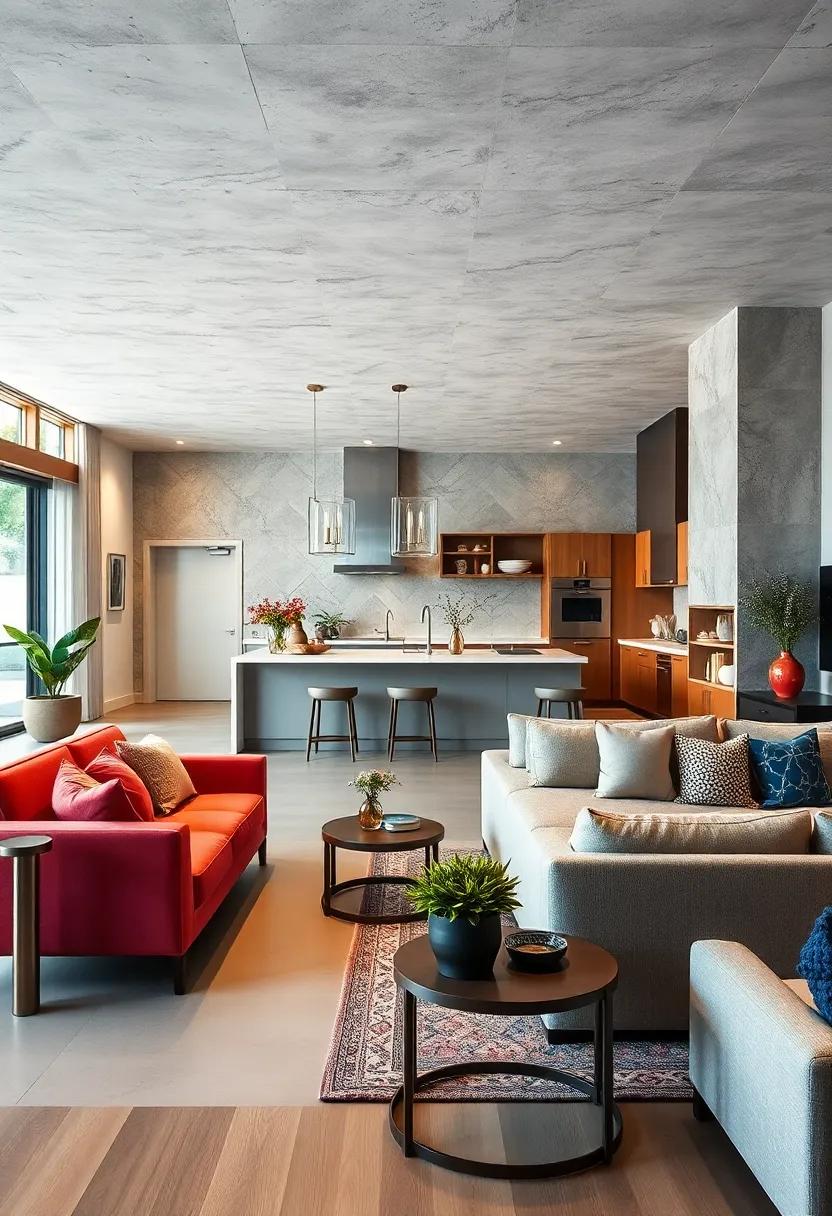
Inject vibrancy into your open concept kitchen and living room by selecting a singular wall to transform into an accent focal point. Whether it’s a striking deep teal in the dining nook or a sunlit mustard yellow behind the sofa, the introduction of a bold hue instantly energizes the space without overwhelming it.To maintain flow, complement the accent wall with matching decor pieces such as throw pillows, vases, or a statement rug, creating a cohesive yet dynamic look that invites warmth and personality.
for those hesitant to commit to paint, vibrant decor offers a flexible choice to experiment with color. Consider color-blocking shelves, bold artwork, or whimsical lighting fixtures to punctuate your neutral tones and bring life to corners that often go unnoticed. Pairing multiples of these pieces within the open layout helps define distinct living zones while maintaining visual harmony.
| Accent Color | Suggested Decor Piece | effect |
|---|---|---|
| Emerald Green | Ceramic Planters | Fresh, natural vibe |
| Coral | Textured Throw Blankets | Warmth & coziness |
| Royal Blue | Metallic Lamps | Modern, elegant touch |
| Sunflower Yellow | Dining chairs | Cheerful energy boost |
Invest in soundproofing elements to balance noise levels while maintaining openness
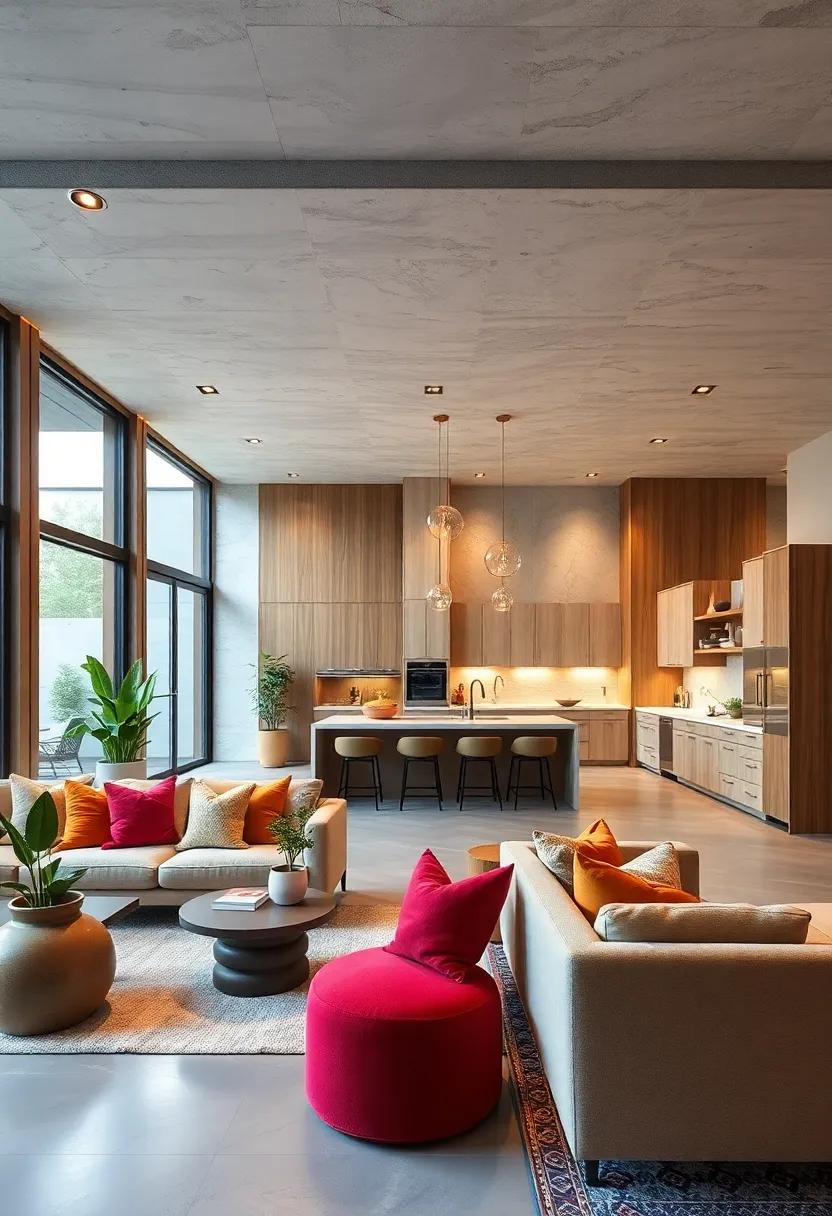
Creating a harmonious blend between lively conversations and peaceful moments is essential in an open concept space. To achieve this, incorporating sound-absorbing materials like acoustic panels, plush area rugs, and heavy curtains can dramatically reduce noise reverberation without compromising the airy feel. Strategic placement of upholstered furniture and bookshelves also works wonders in diffusing sounds, providing subtle boundaries that visually maintain openness but audibly soften the atmosphere.
Consider layering soundproofing solutions for an effective balance. Combining soft textiles with structural elements such as glass partitions with soundproofing seals or ceiling clouds can isolate sound without blocking natural light or sightlines. Below is a quick guide to popular soundproofing choices that blend seamlessly with modern open plan designs:
| Soundproofing Element | Key Benefits | Design Tip |
|---|---|---|
| Acoustic Wall Panels | Reduces echo & absorbs mid-to-high frequencies | choose natural textures or colors for subtle integration |
| Area Rugs & Carpets | Softens footsteps and muffles general ambient noise | Go for patterned designs that complement your decor |
| Upholstered Furniture | Absorbs sound and adds comfort | Opt for larger pieces in key social zones |
| Soundproof Curtains | Blocks outdoor noise and dampens interior sounds | Use layered curtains for adjustable sound control |
| Glass Partitions | Visually open yet isolates sound | Frame with slim profiles to maintain minimalist style |
Incorporate artwork or statement pieces to draw the eye and anchor the room’s design
Bold artwork or a striking statement piece can transform an open concept kitchen and living room from ordinary to remarkable. Consider a large, colorful canvas or a sculptural wall installation that instantly captures attention and anchors the space. These focal points not only add personality but also create visual boundaries in the open layout, subtly defining the living and cooking areas without disrupting the flow. Opt for art that complements your color palette and material choices to maintain harmony across the combined space.
When selecting your statement pieces, think beyond traditional paintings. An oversized mirror with an ornate frame can bounce light and open up the room, while a unique chandelier or pendant light fixture doubles as functional art suspended between zones. For a curated look, arrange a gallery wall mixing textures, shapes, and frames – this creates depth and invites conversation. Here’s a quick overview of ideas to consider:
| Type | Impact | Placement Tip |
|---|---|---|
| Large Canvas | Color infusion and focal point | above the couch or main kitchen wall |
| Sculptural Wall Art | Textural contrast and 3D interest | Near entry or adjacent to dining area |
| Statement Lighting | Functional art that highlights zones | Over island or sofa |
| Gallery Wall | Layered design and storytelling | Along a long corridor wall connecting spaces |
Place strategic mirrors to reflect light and enhance the perception of space
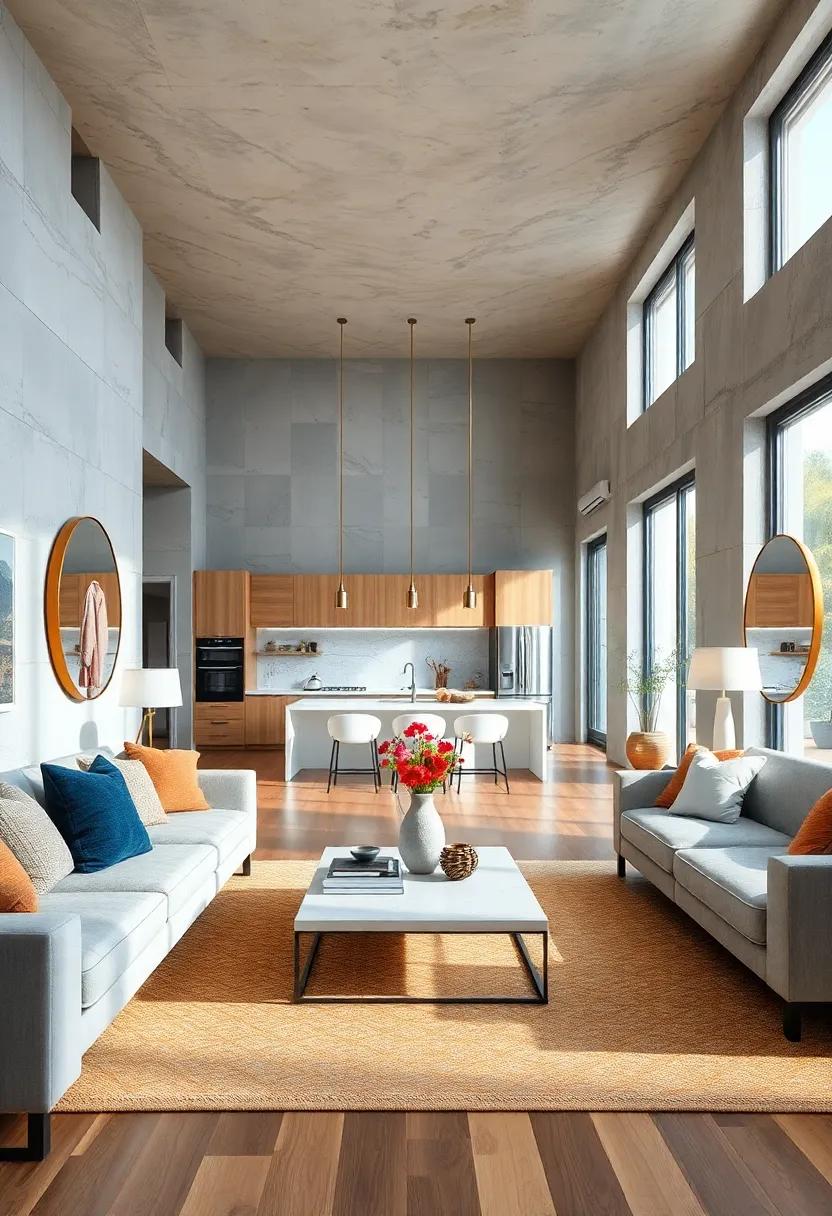
In an open concept kitchen and living room, the clever placement of mirrors can dramatically alter the ambiance by bouncing natural and artificial light throughout the space. Positioning mirrors opposite windows or light fixtures amplifies brightness, making your open layout feel even more airy and inviting. Consider using floor-length mirrors behind a seating area or sleek, framed pieces above kitchen counters to serve dual purposes of elegance and light reflection.
Beyond just illuminating the room, mirrors create an illusion of depth, cleverly expanding the perception of square footage without any renovation. To maximize this effect, try:
- Grouping small mirrors in artistic arrangements to add visual intrigue.
- Choosing reflective surfaces with interesting shapes or subtle textures to prevent flatness.
- Incorporating mirrored backsplashes in the kitchen area for extra shine and functionality.
Prioritize ergonomic layouts that facilitate movement and ease between kitchen and living zones
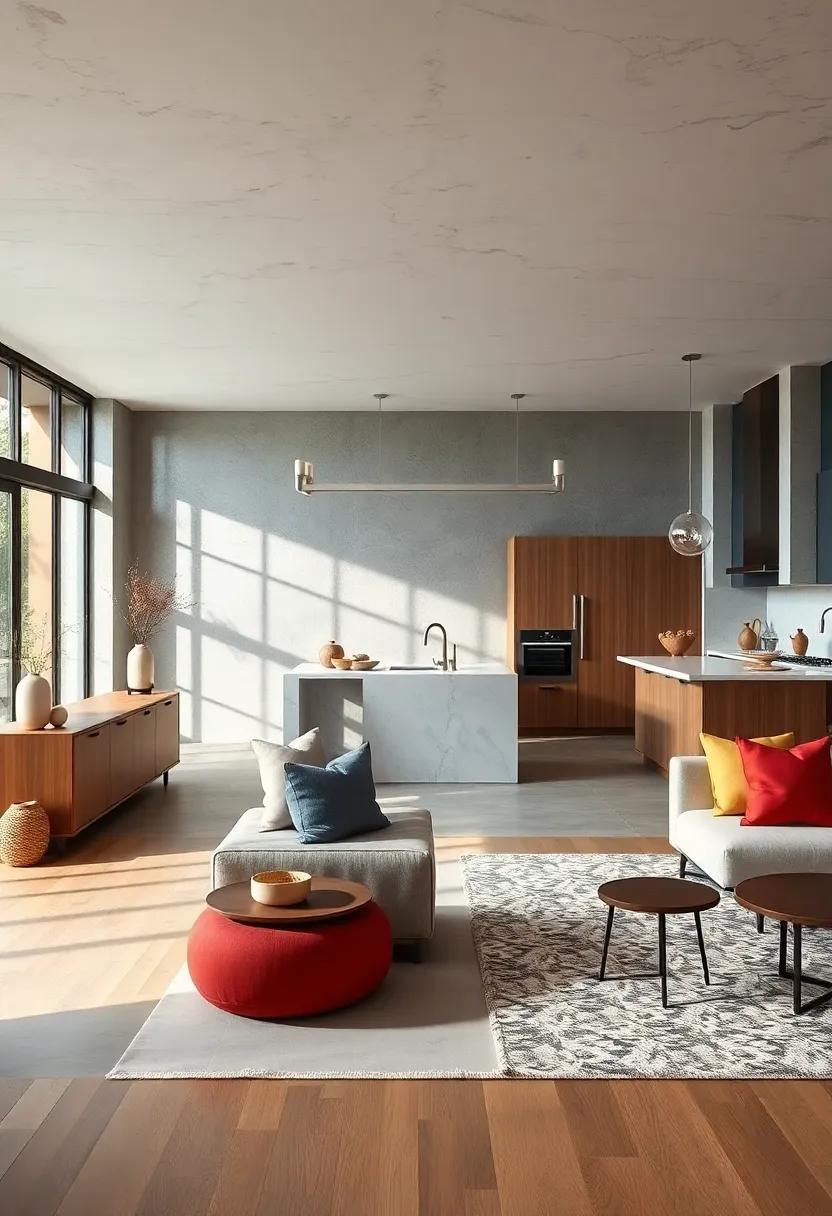
To create a harmonious flow in your open concept space, arrange furniture and appliances with movement in mind. Position key kitchen elements like the sink, stove, and refrigerator close enough for efficient meal prep, yet leave ample room for walkways to prevent congested zones. Consider placing the island or breakfast bar as a natural divider, allowing for seamless interaction between cooking and lounging areas without obstructing traffic paths. Incorporating rugs or subtle floor pattern changes can also guide movement intuitively, helping define zones without closing off spaces.
Tip: Use multifunctional furniture that enhances accessibility and promotes easy transitions, such as mobile kitchen carts or swivel chairs in the living area. Here’s a quick comparison of layout styles and their effect on movement efficiency:
| Layout Style | Movement Flow | Best For |
|---|---|---|
| Linear | Straightforward, easy path | Small spaces, minimal traffic |
| L-Shaped | Natural corner interaction | Medium-sized rooms, clear zones |
| U-Shaped | Efficient work triangle | Open, larger areas with high usage |
| Island Focused | Central hub, multiple access points | Social cooking, entertaining spaces |
Select contrasting textures, such as sleek countertops and soft upholstery, for dynamic layering
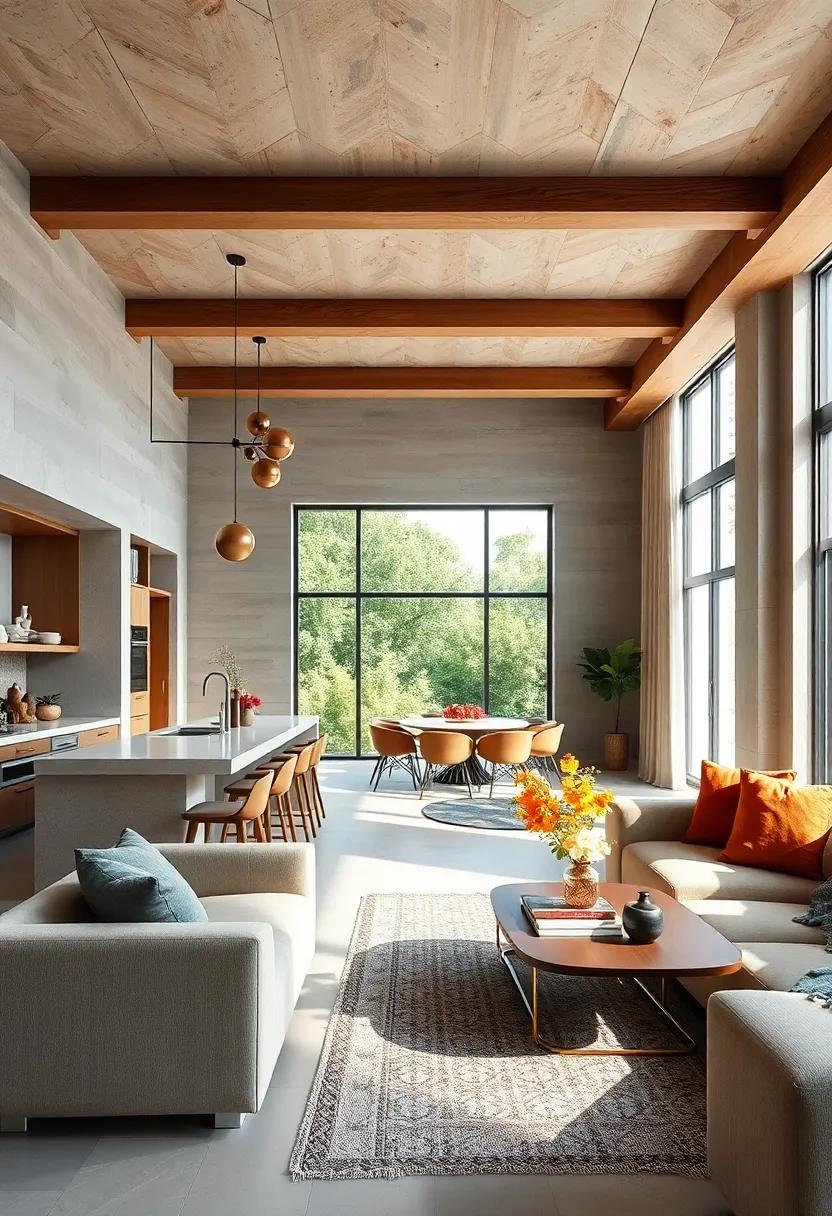
Incorporating a variety of textures can breathe life into your open concept kitchen and living area, creating a seamless yet visually captivating flow. Imagine the cool, polished surface of quartz or marble countertops contrasted with the plush embrace of velvet or boucle upholstery on your sofas and chairs. This interplay of tactile sensations adds depth and invites touch, making the space not only stylish but inviting and comfortable. Such contrasts emphasize the functional zones within an open floor plan without erecting physical barriers, allowing for a harmonious blend of form and function.
To help balance these textures effectively, consider pairing materials with distinct finishes and weights. Such as,a glossy backsplash can be paired with woven linen cushions,or matte wood cabinetry can complement plush leather seating. Below is a simple guide to mix and match textures for a well-layered aesthetic:
| Kitchen Elements | Living Room Counterparts |
|---|---|
| Sleek Granite Countertops | Soft Fabric Upholstery with Loose Cushions |
| Glossy Ceramic Backsplash | Textured Wool Throw Blankets |
| Matte Wood Cabinets | Velvet Accent Chairs |
| Polished Stainless Steel Appliances | Chunky Knit Poufs |
Incorporate greenery or a vertical garden to purify air and introduce natural beauty
Breathing life into your open concept kitchen and living room can be as simple as introducing lush greenery that doubles as a natural air purifier. Incorporating plants like spider plants, snake plants, or pothos not only enhances the aesthetic appeal but also works tirelessly to filter toxins and increase oxygen levels. Position these verdant companions near windows or on floating shelves to create focal points that effortlessly blend nature with your modern décor. Consider grouping different sizes and leaf textures to add depth and vibrancy, turning your space into a refreshing oasis.
For a bolder statement, a vertical garden acts as an eye-catching living art installation that maximizes green space without cluttering your room. These wall-mounted gardens can be custom-designed to fit any size and style, from sleek, minimalist frames to rustic wooden panels.Maintenance-friendly options like succulents or herbs ensure you enjoy beauty and functionality with minimal effort. Here’s a quick guide to some popular plants ideal for vertical gardens:
| Plant | Air Purifying Benefits | Care Level |
|---|---|---|
| Spider Plant | Removes formaldehyde and carbon monoxide | Low |
| Peace Lily | Filters mold spores and VOCs | Medium |
| Herbs (Basil, Mint) | Boosts air freshness and culinary use | Medium |
| Snake Plant | Produces oxygen at night | Low |
| Boston Fern | Reduces indoor air pollution | High |
Use minimalistic cabinetry designs with handle-less fronts to streamline the kitchen’s appearance
Embracing cabinetry with sleek, handle-less fronts instantly elevates the modern aesthetic of your open concept kitchen and living area. These minimalist designs eliminate visual clutter, allowing clean lines to dominate and create a seamless flow between spaces. Without protruding handles, the cabinetry appears as smooth, uninterrupted planes that reflect light and make the entire area feel more spacious and inviting. This subtle sophistication works especially well in open layouts where every design detail contributes to a cohesive, airy atmosphere.
Beyond aesthetics, handle-less cabinets offer functional benefits that complement a busy household. Their easy-to-operate push-to-open mechanisms or integrated grooves simplify access while maintaining the streamlined look. Consider pairing this style with soft-close hinges for a whisper-quiet experience that enhances daily comfort. To further elevate the harmony of your space, opt for neutral or matte finishes that blend effortlessly with your living room’s palette.
Design with sustainability in mind by choosing eco-friendly materials and energy-efficient appliances
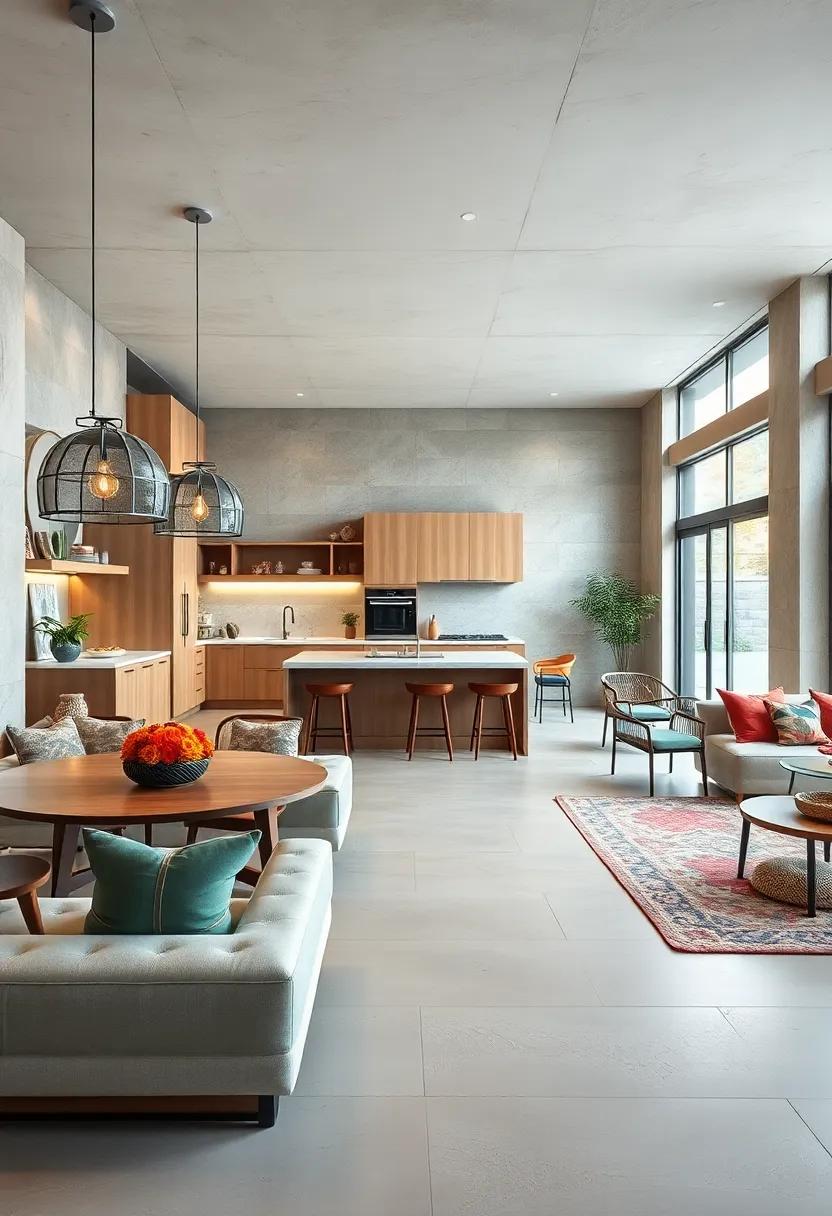
Opting for eco-friendly materials not only reduces your environmental footprint but also infuses your open concept kitchen and living room with natural beauty and durability. Consider countertops crafted from recycled glass or bamboo, cabinetry made from reclaimed wood, or flooring using sustainably harvested materials. These choices offer a unique texture and warmth that enhances the inviting atmosphere of your shared space. Low-VOC paints and finishes further improve indoor air quality, creating a healthier environment for you and your family.
Incorporating energy-efficient appliances is equally crucial in cultivating a sustainable living area. Modern refrigerators, dishwashers, and lighting fixtures labeled with the ENERGY STAR certification consume less power, lowering utility bills without sacrificing performance. To visualize potential energy savings, check out this simple comparison:
| Appliance | Standard Model Energy Use | Energy-Efficient Model Energy Use | Annual Savings |
|---|---|---|---|
| Refrigerator | 600 kWh | 400 kWh | 200 kWh |
| Dishwasher | 300 kWh | 180 kWh | 120 kWh |
| LED Lighting (Kitchen) | 200 kWh | 80 kWh | 120 kWh |
- Smart thermostats to optimize heating and cooling
- Solar-powered ventilation fans for improved airflow
- Water-saving faucets and fixtures
Key Takeaways
Whether you’re dreaming of a sleek modern space or a cozy, inviting haven, these 25 inspiring ideas offer a wealth of possibilities to craft the perfect open concept kitchen and living room. By blending functionality with style, you can create a harmonious environment where cooking, relaxing, and entertaining flow effortlessly together. Remember,the best design reflects your personal taste while enhancing everyday living-so take these ideas as a starting point,and let your creativity shape a space that truly feels like home.
As an Amazon Associate I earn from qualifying purchases.
